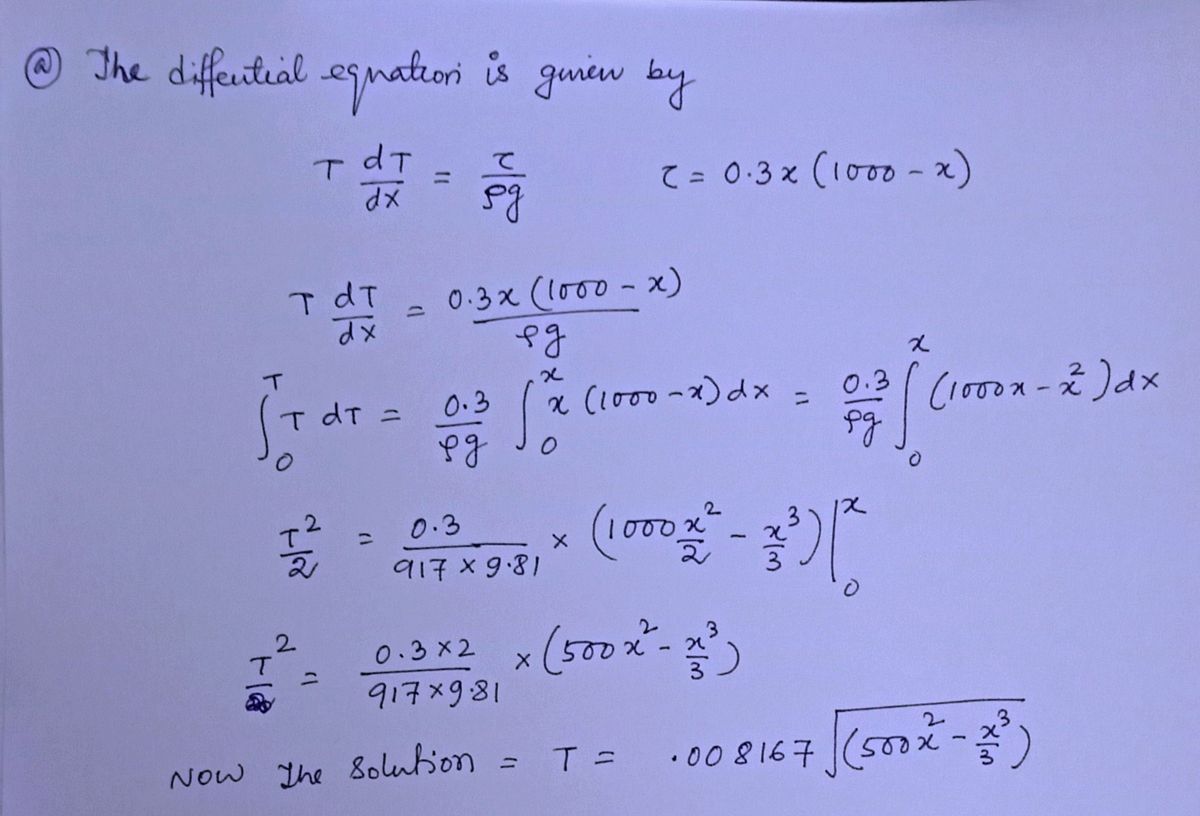a. Find the particular solution with initial condition Z(0) = 0. T dT T == dx pg b. Use T(x) to determine the thickness of the glacier at 1 km. Then graph the function T Desmos and the solution point. Make sure to scale the graph so I can see it well.
a. Find the particular solution with initial condition Z(0) = 0. T dT T == dx pg b. Use T(x) to determine the thickness of the glacier at 1 km. Then graph the function T Desmos and the solution point. Make sure to scale the graph so I can see it well.
Related questions
Question
PLEASE ANSWER ALL PARTS ASAP!!!!!!!
![**Understanding Glacier Thickness through Differential Equations**
In this lesson, we will explore how to determine the thickness of a glacier using differential equations. The glacier thickness is represented by the function \( T(x) \), and is influenced by the variable \( \tau(x) \).
### Problem Statement
We are given the glacier thickness differential equation with:
\[ \tau(x) = 0.3x(1000 - x) \, \text{N/m} \]
With parameters:
- \( \rho = 917 \, \text{kg/m}^3 \)
- \( g = 9.8 \, \text{m/s}^2 \)
**Tasks:**
1. **Finding the Particular Solution:**
- **Initial Condition:** \( T(0) = 0 \).
- **Differential Equation:**
\[
\frac{dT}{dx} = \frac{\tau}{\rho g}
\]
2. **Analyzing Glacier Thickness:**
- Calculate the glacier's thickness at 1 km.
- Graph the function \( T(x) \) using Desmos, highlighting the solution point, and ensure the graph is appropriately scaled for clarity.
### Visual Explanation
The equation indicates that the rate of change in glacier thickness, \( \frac{dT}{dx} \), is equal to the stress \( \tau \) divided by the product of density \( \rho \) and gravitational acceleration \( g \).
#### Guidance for Graphing:
- Use appropriate scaling in Desmos to visualize changes in \( T(x) \).
- Highlight the point where \( x = 1 \) km to examine the glacier thickness at this position.
By following these steps, students will gain a better understanding of how mathematical models can be used to analyze real-world phenomena such as glacier dynamics.](/v2/_next/image?url=https%3A%2F%2Fcontent.bartleby.com%2Fqna-images%2Fquestion%2Fc2daf8f3-113d-48f5-9b15-0b37d7046821%2F5a36e523-2ba4-4600-830d-7c5aa9006095%2Fu7gm6i8_processed.png&w=3840&q=75)
Transcribed Image Text:**Understanding Glacier Thickness through Differential Equations**
In this lesson, we will explore how to determine the thickness of a glacier using differential equations. The glacier thickness is represented by the function \( T(x) \), and is influenced by the variable \( \tau(x) \).
### Problem Statement
We are given the glacier thickness differential equation with:
\[ \tau(x) = 0.3x(1000 - x) \, \text{N/m} \]
With parameters:
- \( \rho = 917 \, \text{kg/m}^3 \)
- \( g = 9.8 \, \text{m/s}^2 \)
**Tasks:**
1. **Finding the Particular Solution:**
- **Initial Condition:** \( T(0) = 0 \).
- **Differential Equation:**
\[
\frac{dT}{dx} = \frac{\tau}{\rho g}
\]
2. **Analyzing Glacier Thickness:**
- Calculate the glacier's thickness at 1 km.
- Graph the function \( T(x) \) using Desmos, highlighting the solution point, and ensure the graph is appropriately scaled for clarity.
### Visual Explanation
The equation indicates that the rate of change in glacier thickness, \( \frac{dT}{dx} \), is equal to the stress \( \tau \) divided by the product of density \( \rho \) and gravitational acceleration \( g \).
#### Guidance for Graphing:
- Use appropriate scaling in Desmos to visualize changes in \( T(x) \).
- Highlight the point where \( x = 1 \) km to examine the glacier thickness at this position.
By following these steps, students will gain a better understanding of how mathematical models can be used to analyze real-world phenomena such as glacier dynamics.
Expert Solution
Step 1: Part a

Step by step
Solved in 4 steps with 3 images
